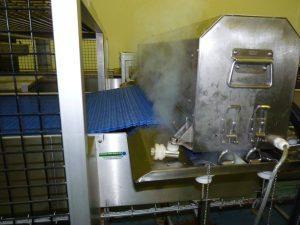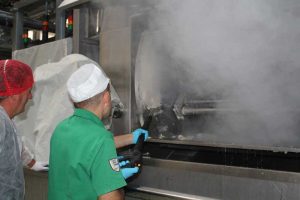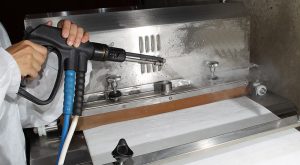Conveyor belt washing systems play a crucial role in maintaining the cleanliness and efficiency of conveyor belts across various industries. These systems are designed to remove dirt, debris and other contaminants from the conveyor belts, ensuring they operate smoothly and effectively. Without proper cleaning, conveyor belts can become clogged and damaged, leading to costly downtime and repairs.
Moreover, dirty conveyor belts can contaminate products and compromise the quality and safety of the end products. Therefore, investing in a reliable conveyor belt washing system is essential for ensuring the smooth operation and hygiene of conveyor belts in industrial settings. Furthermore, conveyor belt washing systems are important for maintaining compliance with industry regulations and standards.
Many industries, such as food processing, pharmaceuticals and manufacturing, are required to adhere to strict cleanliness and hygiene standards to ensure the safety and quality of their products. Conveyor belt washing systems help these industries meet these standards by effectively removing contaminants and maintaining a clean and sanitary production environment. By investing in a high-quality conveyor belt washing system, businesses can demonstrate their commitment to upholding industry regulations and ensuring the safety and integrity of their products.
Summary
- Conveyor belt washing systems are important for maintaining hygiene, preventing contamination, and extending the lifespan of conveyor belts.
- Using conveyor belt washing systems can lead to improved product quality, reduced maintenance costs, and increased operational efficiency.
- There are various types of conveyor belt washing systems available, including manual, automated, and portable systems, each with their own advantages and limitations.
- When choosing a conveyor belt washing system, factors to consider include the type of conveyor belt, the level of contamination, the required cleaning frequency, and the available space for installation.
- Best practices for maintaining cleanliness with conveyor belt washing systems include regular inspection, proper cleaning procedures, and using suitable cleaning agents to avoid damage to the conveyor belt.
Benefits of Using Conveyor Belt Washing Systems
Increased Productivity and Cost Savings
This, in turn, leads to increased productivity and cost savings for businesses. In addition, conveyor belt washing systems contribute to the maintenance of a hygienic and safe working environment.
Maintenance of a Hygienic Environment
By removing contaminants from conveyor belts, these systems help to prevent the spread of bacteria and other harmful substances that could compromise the safety and quality of products. This is particularly important in industries such as food processing and pharmaceuticals, where cleanliness and hygiene are paramount.
Meeting the Highest Standards
By investing in a conveyor belt washing system, businesses can ensure that their production environment meets the highest standards of cleanliness and safety.
Types of Conveyor Belt Washing Systems

There are several types of conveyor belt washing systems available, each designed to meet specific cleaning requirements and industry needs. One common type is the spray bar system, which uses high-pressure water jets to effectively remove dirt and debris from conveyor belts. This system is ideal for industries with heavy soiling or where thorough cleaning is required.
Another type of conveyor belt washing system is the brush system, which uses rotating brushes to scrub the surface of the conveyor belt and remove contaminants. This system is particularly effective for removing stubborn residues and sticky substances from conveyor belts. Additionally, there are foam cleaning systems that use a combination of foam and water to clean conveyor belts.
This method is gentle yet effective, making it suitable for industries where delicate products or materials are being transported on the conveyor belts.
Factors to Consider When Choosing a Conveyor Belt Washing System
When choosing a conveyor belt washing system, there are several factors that businesses should consider to ensure they select the most suitable system for their needs. Firstly, it is important to consider the level of soiling and contamination on the conveyor belts, as this will determine the type of cleaning system required. Industries with heavy soiling may benefit from a high-pressure spray bar system, while those with lighter contamination may find a brush or foam cleaning system more suitable.
Another important factor to consider is the size and layout of the conveyor belt system. Businesses should choose a washing system that can be easily integrated into their existing conveyor belt setup without causing disruption to operations. Additionally, it is essential to consider the maintenance requirements and operating costs of the washing system to ensure it is sustainable in the long term.
Best Practices for Maintaining Cleanliness with Conveyor Belt Washing Systems
To maintain cleanliness and effectiveness with conveyor belt washing systems, it is important to implement best practices for their use and maintenance. Regular inspection and cleaning of the washing system components, such as nozzles, brushes, or foam applicators, are essential to ensure they are functioning optimally. Additionally, businesses should establish a regular cleaning schedule for their conveyor belts to prevent the buildup of dirt and contaminants.
Furthermore, training employees on the proper use of the conveyor belt washing system is crucial for maintaining cleanliness and safety in the production environment. Employees should be educated on how to operate the system effectively and safely to ensure that it delivers consistent cleaning results.
Cost-Effectiveness of Conveyor Belt Washing Systems

Reducing Downtime and Repairs
By investing in a high-quality washing system, businesses can reduce the risk of costly downtime and repairs associated with dirty or damaged conveyor belts. This leads to increased productivity and cost savings in the long run.
Improving Production Efficiency
Additionally, clean conveyor belts contribute to the overall efficiency of production processes by reducing the risk of product contamination or quality issues.
Enhancing Product Quality and Customer Satisfaction
This can lead to improved product quality and customer satisfaction, ultimately benefiting the bottom line of businesses.
Environmental Impact of Conveyor Belt Washing Systems
Conveyor belt washing systems can have a positive environmental impact by reducing water consumption and chemical usage compared to traditional cleaning methods. Many modern washing systems are designed to be water-efficient, using minimal water while still delivering effective cleaning results. Additionally, some systems are equipped with recycling capabilities that allow for the reuse of water, further reducing water consumption.
Furthermore, by effectively removing contaminants from conveyor belts, these systems help to prevent pollution and environmental damage that could result from the spread of harmful substances. This is particularly important in industries where strict environmental regulations must be adhered to. In conclusion, conveyor belt washing systems play a vital role in maintaining cleanliness, efficiency, and compliance in industrial settings.
By investing in a high-quality washing system and implementing best practices for its use and maintenance, businesses can benefit from increased productivity, cost savings, and a safer working environment. Additionally, these systems can have a positive environmental impact by reducing water consumption and preventing pollution. Therefore, businesses should carefully consider their cleaning requirements and choose a conveyor belt washing system that best meets their needs for optimal performance and sustainability.
FAQs
What are conveyor belt washing systems?
Conveyor belt washing systems are automated machines designed to clean conveyor belts in industrial settings. They use water, detergent, and mechanical scrubbing to remove dirt, debris, and contaminants from the belts.
Why are conveyor belt washing systems essential for maintaining cleanliness?
Conveyor belt washing systems are essential for maintaining cleanliness in industrial settings because they help to prevent the build-up of dirt, debris, and contaminants on the conveyor belts. This not only ensures product quality and safety but also extends the lifespan of the belts and reduces the risk of equipment breakdowns.
How do conveyor belt washing systems work?
Conveyor belt washing systems work by spraying water and detergent onto the conveyor belts while simultaneously using mechanical brushes or scrubbers to agitate and remove dirt and debris. The dirty water is then collected and filtered before being recycled, reducing water consumption and environmental impact.
What are the benefits of using conveyor belt washing systems?
The benefits of using conveyor belt washing systems include improved product quality, reduced risk of contamination, extended belt lifespan, decreased equipment downtime, and compliance with hygiene and safety regulations. Additionally, these systems can help to reduce water usage and environmental impact through recycling and filtration processes.
What industries can benefit from using conveyor belt washing systems?
A wide range of industries can benefit from using conveyor belt washing systems, including food and beverage processing, pharmaceuticals, manufacturing, packaging, and logistics. Any industry that uses conveyor belts to transport products or materials can benefit from the cleanliness and maintenance provided by these systems.










